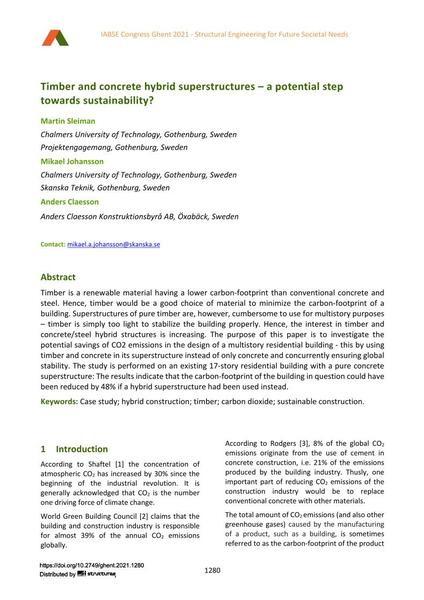Timber and concrete hybrid superstructures – a potential step towards sustainability?

|
|
|||||||||||
Bibliografische Angaben
| Autor(en): |
Martin Sleiman
(Chalmers University of Technology, Gothenburg, Sweden Projektengagemang, Gothenburg, Sweden)
Mikael Johansson (Chalmers University of Technology, Gothenburg, Sweden Skanska Teknik, Gothenburg, Sweden) Anders Claesson (Anders Claesson Konstruktionsbyrå AB, Öxabäck, Sweden) |
||||
|---|---|---|---|---|---|
| Medium: | Tagungsbeitrag | ||||
| Sprache(n): | Englisch | ||||
| Tagung: | IABSE Congress: Structural Engineering for Future Societal Needs, Ghent, Belgium, 22-24 September 2021 | ||||
| Veröffentlicht in: | IABSE Congress Ghent 2021 | ||||
|
|||||
| Seite(n): | 1280-1287 | ||||
| Anzahl der Seiten (im PDF): | 8 | ||||
| DOI: | 10.2749/ghent.2021.1280 | ||||
| Abstrakt: |
Timber is a renewable material having a lower carbon-footprint than conventional concrete and steel. Hence, timber would be a good choice of material to minimize the carbon-footprint of a building. Superstructures of pure timber are, however, cumbersome to use for multistory purposes timber is simply too light to stabilize the building properly. Hence, the interest in timber and concrete/steel hybrid structures is increasing. The purpose of this paper is to investigate the potential savings of CO₂ emissions in the design of a multistory residential building - this by using timber and concrete in its superstructure instead of only concrete and concurrently ensuring global stability. The study is performed on an existing 17-story residential building with a pure concrete superstructure: The results indicate that the carbon-footprint of the building in question could have been reduced by 48% if a hybrid superstructure had been used instead. |
||||
| Stichwörter: |
Nachhaltiges Bauen Fallstudie Kohlendioxid Hybridkonstruktion
|
||||
| Copyright: | © 2021 International Association for Bridge and Structural Engineering (IABSE) | ||||
| Lizenz: | Die Urheberrechte (Copyright) für dieses Werk sind rechtlich geschützt. Es darf nicht ohne die Zustimmung des Autors/der Autorin oder Rechteinhabers/-in weiter benutzt werden. |
||||
